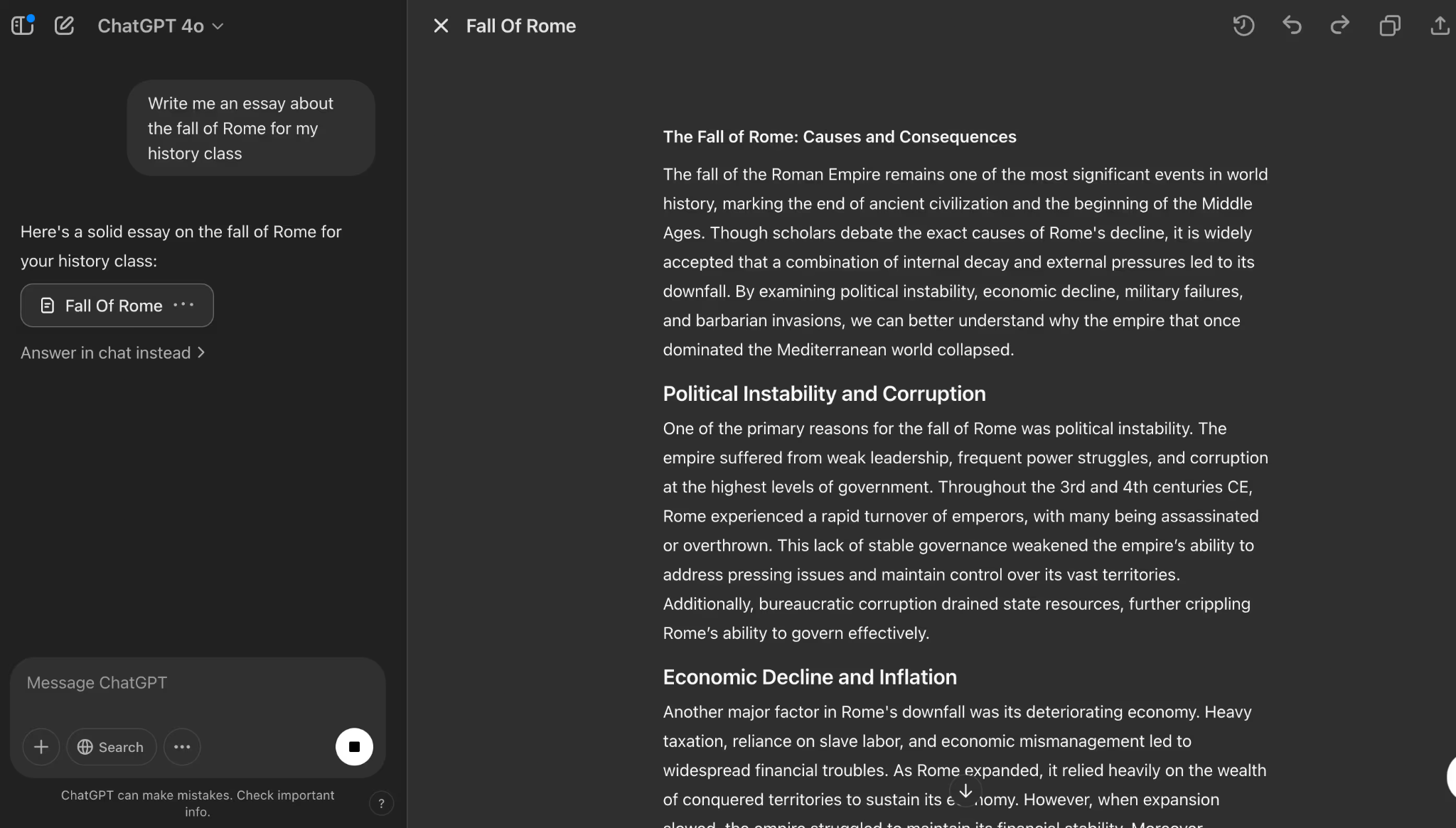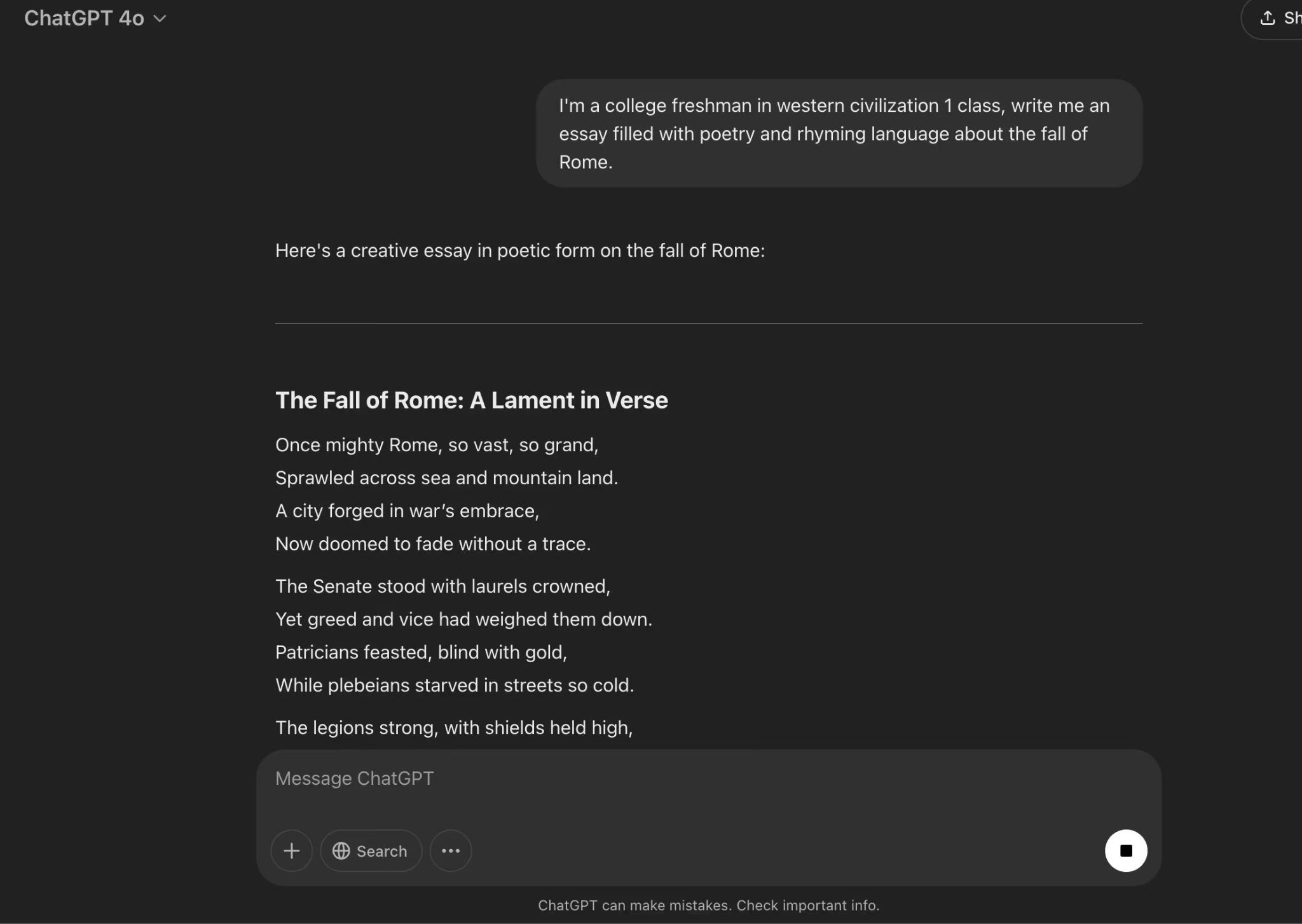We’ve created many guides for students on writing strong essays before. These guides cover the key steps to make academic writing impactful.
Often, these guides suggest using AI to improve writing. But in this guide, I’ll show how users can create the best essays from top prompts.
Whether you use AI tools like ChatGPT or hidden chatbots, this guide will help make those AI models produce the writing you need.
Table of Contents
- The 4 Keys to Effective AI Prompts
- Persona
- Context
- Task
- Formatting
- More Tips for Using AI for Essays
- Conclusion
The 4 Keys to Effective AI Prompts
To get the best results from AI, especially for writing tasks, there are four key ways to break down a good prompt. Whether you’re writing for school, marketing, email, or social media, these tips can help.
Let’s look at these four elements with an example. Here’s an essay created by ChatGPT using a simple writing prompt.

Observe the broad ideas in the essay, and check how they change when we add specific details.
Persona
When you want your AI to craft an essay, it’s helpful to give a brief about yourself. This helps the AI chatbot tailor its writing for you.
For example, by sharing details like: “I’m a new college student from Los Angeles who loves The Dodgers and movies, and I need to write an essay on why Los Angeles is the best city in the USA,” your AI will provide content that sounds more like you and meets the essay’s goals.
This applies to other writing too. Need to email a teacher? Instead of just asking the AI to write an email requesting a class change, explain that you’re a student in a creative field needing to switch classes to better suit your creative goals.
Here’s our Persona-based prompt and the essay ChatGPT generated from it:

More personal details led to changes in how language was used and the ideas shared.
Task
When you ask an AI to make content, it helps to be clear about what you need. If it’s an essay, tell it the type and aim of the essay. This way, the result matches what your teacher wants.
For example, instead of saying, “Write me an essay about the fall of Rome for my history class,” you could say, “I’m a senior in college. Write a compare and contrast essay about the fall of Rome for my Advanced Western Civilization class. Include comparisons to other fallen empires and present-day America.”
Context
An AI prompt’s context describes how you want the AI to do its job. For instance, instead of just saying, “Write me an essay for history class,” you could say, “Create a poetic history essay with metaphors, arguing that understanding history is subjective.”
Adding context to prompts helps your writing connect better with your intended audience.

Our prompt above provides more details about the writing style desired for the essay.
Format
There are lots of essay types schools may request, especially for citing sources. You might even instruct your AI to craft a compare and contrast essay with seven paragraphs if needed.
Instruct your AI to follow a standard essay format: place the thesis correctly, start with a hook, outline each main paragraph, address counter-arguments, and wrap up with a solid conclusion.

The image above displays a prompt example with many formatting rules that ChatGPT adheres to well in its response.
More Tips For Using AI For Essays
AI programs struggle with academic jobs because they don’t mimic how people write. To make your papers work for school and avoid AI detection, students should use special AI tools that stay hidden. For those writing for ads or online, you won’t get expelled, but search engines might lower your rank if they spot AI-written content.
There are ways to protect your essays. Start by using AI to draft, then tweak it to reflect your voice and ideas. Also, using AI for spell check or feedback is smart. It helps blend AI smoothly into your writing routine.
Conclusion
To tap into the full potential of your academic writing, beginning with crafting effective AI prompts is key. Though prompt engineering might appear daunting, it’s simpler than it seems.
The trick to creating better prompts for your AI model and getting the results you want lies in the specific details you share about yourself, the task, and the intended audience.
When crafting prompts for any AI tool, ensure you provide information about yourself, helping the AI to capture your tone. Describe the essay clearly, so the AI understands its task.
Supply all necessary details, enabling the AI to tailor the essay for your class. Specify the formatting requirements, so your essay appears just right.
AI has numerous applications in academic writing and digital marketing, from brainstorming to coaching and ghostwriting. These tools streamline tasks for professional writers and reduce workloads for students.
While automation might still raise eyebrows in academic circles, embracing AI now could be advantageous, preventing you from lagging once the technology becomes widespread.
